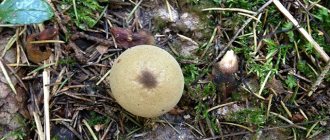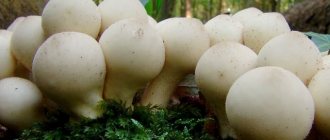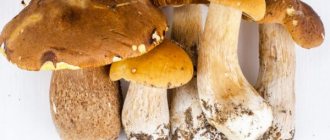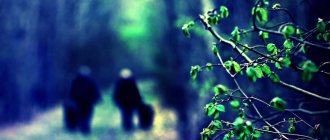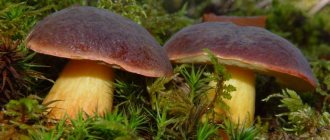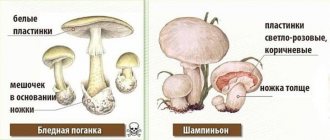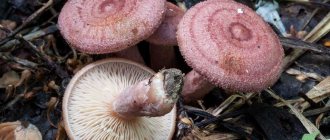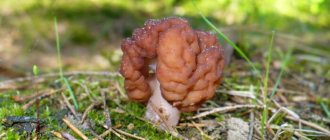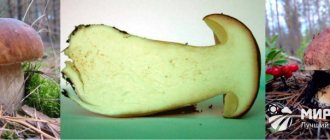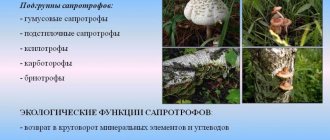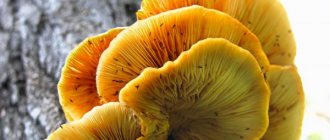Raincoat (lat. Lycoperdon) is a genus of mushrooms of the Champignon family. Also known as pearl or real raincoat. Popularly, mature specimens are called:
- tobacco mushroom;
- flutter;
- dust duster;
- wolf tobacco;
- grandfather's tobacco;
- wolf tobacco.
This type of mushroom received its popular name for its property of smoking when pressed.
Young fruiting bodies are called bee sponge or hare potato.
Description
The mushroom is an edible puffball.
Fruiting body
The raincoat is edible.
Unlike cap mushrooms, the fruiting body of the puffball is spherical, spherical, sometimes pear-shaped or club-shaped. The upper part reaches a size of 2-5 centimeters, in height, together with the “ leg” (in fact, this is also part of a single fruiting body) - up to 10 cm.
The young mushroom is pearly white in color, hence the second part of its Latin name - “pearl”. The skin of a young raincoat is covered with small growths in the form of thorns, which are easily separated when touched; with age, the skin turns brown.
The leg is missing
Pulp
Hare potatoes.
The pulp of the young mushroom is white, elastic, slightly loose. As the pulp ripens, it turns green, then olive-brown, and numerous cavities form in it.
Spore powder
It is a fine dust released from the ripe mushroom through perforations in the skin, gray, black, brown or olive-brown in color.
Edible mushrooms
There are a variety of edible mushrooms grown and harvested throughout the world. Mushrooms have a specific taste and smell, some of them are delicacies and have a high price.
Many mushrooms are healthy and nutritious, sometimes called “forest meat” or “plant meat.” Mushrooms are rich in protein (also contain about 1% free amino acids), carbohydrates - specific mushroom sugar mycosis and glycogen (the so-called “animal starch”). Mushrooms contain minerals: potassium, phosphorus, sulfur, magnesium, sodium, calcium, chlorine, and vitamins A (carotene), B vitamins, vitamin C, large amounts of vitamin D and vitamin PP.
Mushrooms also contain enzymes (especially champignons), which, by accelerating the breakdown of proteins, fats and carbohydrates, contribute to better absorption of food.
In the USSR, it was accepted to divide edible mushrooms into four categories of nutritional value (according to B.P. Vasilkov):
The fourth category included little-known and rarely collected edible mushrooms.
Currently, they refuse to divide mushrooms into food categories; for each type, an individual description of the nutritional value is given, often indicating national characteristics in world cuisine.
Conditionally edible mushrooms most often include mushrooms that are poisonous or have a pungent taste in their raw form, but are quite edible after cooking. Sometimes other reasons for conditional edibility are cited: for example, some mushrooms are edible only at a young age, while others cause poisoning only when combined with certain foods ().
There are several thousand species of edible mushrooms. The vast majority of them are fleshy macromycetes, but some are pathogens of plants and other fungi: for example, Cronartium conigenum, Ustilago maydis, Hypomyces lactifluorum.
Spreading
edible puffball is distributed almost everywhere except Antarctica. It is easy to meet in meadows, in forests of various types (it is not picky about soil acidity), and is often found in pastures, near farms and stables, as it loves manured soils. It appears most often after rain, which is why it owes its Russian name.
Tobacco mushroom.
It grows mainly from late July to mid-September.
Growing at home and in the country
Many gardeners grow champignons and porcini mushrooms on their plots, but there are much fewer people who want to grow raincoats.
And there is a reason for this: the shelf life of dust pollen is very short, because even in the refrigerator it continues to ripen and becomes tasteless.
Nevertheless, growing raincoats at home is quite simple, especially since they are very nutritious and healthy. Various medicinal tinctures are prepared from wolf tobacco; it has cleansing properties and is used in cooking.
To grow dust moths, you need spores that are sown in moist soil. It is desirable that trees grow in this area. Fallen leaves are placed on top. In a year you can already get the first harvest.
Another method of cultivation is also used: mature specimens must be finely chopped and filled with water for a day, and then pour this liquid over the place where you want to breed them. Next year we can already expect their appearance.
Similar species
edible puffball is more or less similar to all representatives puffball genus - hedgehog , etc. Of all its close relatives, only the hedgehog puffball , but it is not poisonous, it just has an unpleasant taste. Inexperienced mushroom pickers may confuse the puffball with a very young Pale grebe (in the “egg” stage) .
1- Hedgehog raincoat. 2- The raincoat is gigantic. 3- Pear-shaped raincoat. 4- Pale grebe.
Caring for the valuable gifts of nature
Puffball mushrooms are a tasty, nutritious, healing product. In addition, they, like other edible mushrooms, are a decoration of the area where they grow.
It is very important to treat them with care: do not destroy them, let the spores mature, and collect them correctly so as not to damage the mycelium.
Every person should take care that these gifts of nature do not disappear, there are more of them, so that they delight with a pleasant taste and healing properties.
Edibility
Many fans of “mushroom hunting” ignore the raincoat, not considering it edible. Meanwhile, although the mushroom is classified only in the 4th taste category, it has a very delicate and pleasant taste. Only the completely white pulp of the young mushroom is eaten.
As soon as the flesh has darkened, the mushroom is no longer edible and the taste becomes unpleasant. Raincoat makes very tasty soups and can also be fried. You need to prepare the raincoat immediately after collection; its pulp very quickly, within 2-3 hours, becomes flabby and loses its taste. The raincoat can also be frozen for future use.
Damn tavlinka.
Cooking features
Raincoat has a rather specific taste, so you need to know how to prepare it correctly. There are many recipes for preparing duster: in batter, breadcrumbs, stewed in cream or fried with onions in a frying pan.
Proper preparation for eating
Preparing mushrooms includes three main points:
- First of all, freshly picked fruiting bodies must be thoroughly washed to remove dirt.
Preparing mushrooms - Since the skin of the raincoat is quite tough, it needs to be removed.
Peeling - Prepared mushrooms must be boiled in salted water for 25-30 minutes.
Cooking process
The last step is not mandatory, however, many housewives consider it necessary to subject the mushrooms to additional heat treatment. Having prepared the raincoats, you can start preparing the dish.
You may be interested in:
Original Edelweiss salad with Korean carrots, peppers and champignons Edelweiss salad is inconsistent in its composition, but invariably beautiful and effective when served. In this version, he...Read more...
Recipes
There are many different recipes for cooking golovach. Most of them are very simple, do not require special skills, but are very tasty:
- Dust cakes with sour cream - a tasty and healthy dish consisting of simple ingredients. In order to prepare the dish, you will need: 0.5 kg of raincoats;
- a glass of sour cream;
- 2 onions;
- 100 ml sunflower oil;
- salt and pepper. Prepared mushrooms need to be fried in oil for 20-25 minutes. Separately, saute the diced onion until golden brown. Add the onion to the mushrooms and cook for another 20-25 minutes. 5 minutes before the end of sautéing, add sour cream and spices.
Raincoats in sour cream
- 1 kg of powder flasks;
100 g mayonnaise;
All ingredients must be thoroughly mixed and left to marinate for an hour. Then transfer the mushrooms to a baking sleeve and place in an oven preheated to 200 degrees for 60 minutes. Sprinkle the finished dish with herbs.
Oven baked raincoats
- 300 g raincoats;
4 potatoes;
For dumplings:
- a glass of flour;
- 80 g butter;
- 2 eggs;
- glass of water;
- salt.
Soup with raincoats and dumplings
The first step is to let the potatoes cook for 20 minutes. At this time, chopped mushrooms and onions need to be fried in oil. Then, in a separate bowl, bring water with butter and a pinch of salt to a boil.
Remove it from the heat and, stirring quickly, add the flour. Add eggs one at a time. Throw mushrooms into the soup and, using a teaspoon, add dough for dumplings in small portions. Let simmer for 5 minutes. Then add the greens, stir and remove from heat. Can be served immediately.
All these recipes are simple and affordable, however, thanks to raincoats, they have a unique taste and aroma.
Preparation for the winter
To preserve fluff for the winter, you can dry or pickle them. In order to dry mushrooms, you need to peel them, chop them and boil them. After this, the prepared dust particles should be placed on a baking sheet in one layer. You can dry raincoats in the sun or in the oven at a temperature not exceeding 100 degrees. To marinate mushrooms, you need to prepare the following ingredients:
- raincoats – 1 kg;
- sugar and salt - 10 g each;
- vinegar – 75 ml;
- dill umbrellas - 2-3 pieces;
- garlic – 2 cloves;
- allspice – 6 peas.
Pickled raincoats
Cleaned raincoats must be boiled in salted water for several minutes. Then you need to add all the other ingredients and boil for another quarter of an hour. Place the dust bags in jars and fill them with marinade and seal with lids. The next day, the jars must be taken to the basement.
Interesting things about the raincoat
- It is curious that with such a beautiful Latin species name - “pearl”, the generic name of the raincoat is completely devoid of romance. It is derived from the words “wolf” and “farting”. Something like "farting wolf". Therefore, our raincoat is edible in the language of scientists - a pearly farting wolf.
- The raincoat has also found its use in medicine. Its hemostatic properties have long been appreciated by those who like to wander through the windfall, and dried mushroom powder mixed with honey is an excellent remedy for sore throat, tonsillitis and bronchitis due to its anti-inflammatory properties. In addition, the pulp of the raincoat is an excellent absorbent for heavy metals, which it removes from the body.
Useful properties and contraindications
Raincoat has long been used not only in folk, but also in official medicine for its medicinal properties.
It contains:
- chromium;
- calcium;
- sodium;
- iodine;
- potassium;
- fluorine;
- phosphorus;
- iron;
- zinc;
- rubidium.
- molybdenum.
The mushroom pulp contains amino acids:
- cystine;
- methionine;
- tryptophan;
- phenylalanine.
Beneficial features:
- improves the cardiovascular system;
- cleanses the body and removes radionuclides and toxins;
- increases immunity;
- hemostatic;
- has antitumor properties;
- improves the body's metabolic processes;
- has a beneficial effect on the skin, making it elastic and healthy.
Broths and infusions from young fruiting bodies are used:
- at elevated temperature;
- with high blood pressure, angina pectoris;
- to relieve inflammatory processes, for example, with throat bumps, chronic tonsillitis or severe pain in the kidneys;
- to reduce hemoglobin;
- to inhibit the growth of malignant tumors and the progression of leukemia;
Not recommended for pregnant and lactating women and children under 5 years of age. Take with caution in case of diseases of the pancreas, kidneys and exacerbation of diseases of the gastrointestinal tract. You should not collect mushrooms in areas with poor ecology, near factories and highways, as they may contain toxins and pose a health hazard.
